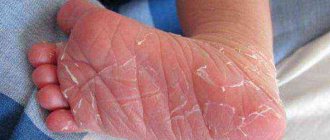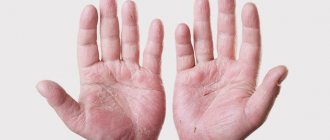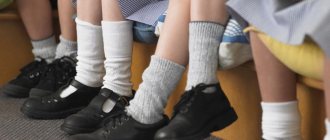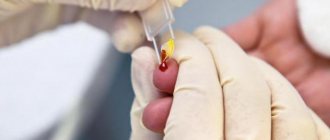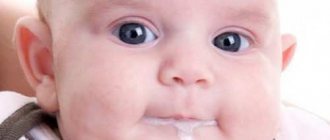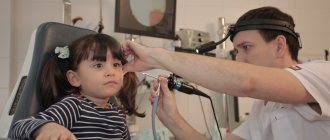Causes
Adaptation. The newborn adapts to external conditions. They get used to contact with the surrounding air, their clothes and even water. The lack of protective vernix causes a reaction on the skin.
What to do: If the child does not itch and there is no swelling, then the spots should go away on their own in a week. All you have to do is follow the rules of hygiene.
Hormones. In newborns, roughness and rashes may appear as a result of excess hormones. What to do: In this case, after 1.5 months the process will resolve itself.
Dry air. If the indoor air is dry, especially in winter during the height of the heating season, the child may also experience peeling. Do not forget that his skin is more sensitive to humidity and its level should be at least 50 and no more than 70%.
What to do: The best solution in this situation is a humidifier. If the latter is not the case, then try to carry out wet cleaning in the nursery more often, and regularly hang wet towels on the radiator. As a last resort, you can place containers of water in the room.
Water. If there is a lack of fluid in the body, the child’s skin begins to react. What to do?
Monitor how much water your baby drinks per day. Add soups, fruit drinks, jelly and plain water to your diet.
Causes of peeling skin in infants
The baby is born into the world covered with vernix. This is a special grayish substance that is formed during its intrauterine development. This is what makes it easier for the baby to pass through the birth canal.
Relatively recently, the baby was wiped after birth, completely cleansing the skin. Today, vernix is most often left to allow it to be absorbed into the baby's skin.
But even in this case, the child’s skin begins to peel off. Sometimes the process is so active that it scares the baby’s mother. Causes of peeling skin may include:
Adaptation of the child’s body to completely new conditions
After birth, the child is forced to adapt to survival in completely new conditions. This concerns not only the body, but also the skin of the baby. They come into contact with air, fabrics, diapers and the reaction can be completely different. But gradually everything returns to normal, and the skin becomes smooth. So if the baby has peeling, but the baby does not show signs of concern, then everything is normal and there is no reason to worry.
The air in the children's room is too dry
It is because of insufficient air humidity in the room where the child spends most of the day that peeling of the skin is observed. The norm is considered to be air humidity in the range of 55...70%. Only in such conditions will the baby be comfortable (the skin will be able to maintain the required level of moisture).
Improper care
In young children, peeling may occur due to improper skin care. If you often use soap and various shampoos that are intended for adults.
What to do: For young children, try to use detergent once a week and wash them with plain water. Also pay attention to how the skin reacts to a particular detergent: if you notice peeling after using it, change it urgently.
Weather. Peeling skin of a child can also react to unfavorable weather conditions: cold, strong wind, active sun. What to do: Do not forget that it is better to take care of protection in advance and use special creams. Apply them not just before going outside, but half an hour before your walk.
Avitaminosis. If a child's facial skin is peeling, then he is experiencing a lack of vitamins. Most often there is a lack of vitamins A, E, C. What to do: diversify your child’s diet. Add more vegetables and fruits to your diet.
Allergy. Possible food allergies may also result in flaking. It is primarily caused by citrus fruits, honey and chocolate. However, the allergen can be animal fur, flowering plants and other factors.
Detailed video:
What to do: consult a doctor. Treatment in this case should be aimed at eliminating both the symptoms and the allergen itself. If peeling appears in a baby, then its mother needs to carefully follow a diet and exclude the above products from her diet, as well as canned smoked foods and spices.
Pathological causes
Peeling of the scalp in a child is a sign of health problems when it causes discomfort or is accompanied by other characteristic symptoms.
In this case, it is better not to be lazy and undergo diagnostics in order to immediately remove the cause of the problem and not engage in an endless struggle with symptoms.
Allergy
The symptom can be caused by an atypical reaction of the body to any allergen. Initially, a characteristic rash and redness appears on the skin. The skin begins to peel as the affected cells die. To stop desquamation, you must first remove the allergen.
Antihistamines and ointments with a regenerative effect can speed up the healing process. If the problem regularly returns, it is better to undergo allergy tests in order to know exactly the cause of the atypical reaction and avoid contact with a substance dangerous to the child.
Fungi
This is one of the most common causes of flaking. For example, in infants it manifests itself as an extensive covering of scales in the hair growth area, nicknamed “birth mud” or scientifically physiological seborrhea. The process develops due to the yeast-like fungi Malassezia restricta and Malassezia globosa.
Despite the scary name, they are completely harmless and live in the skin of all people. Fungi feed on the secretions of the sebaceous glands, preventing excessive oiling. Normally, their numbers are controlled by the immune system, but in infants it is not yet fully formed, which allows the yeast to develop entire colonies.
This is safe and does not cause discomfort to the child, unless you try to specifically remove the scales with tweezers or a comb with sharp teeth.
However, more serious fungal pathologies that affect the scalp are also possible. In this case, microorganisms can have a negative effect on organs.
If a child’s spots spread throughout the body and cover a large area, they itch or become wet, it is better to contact a pediatrician. Treatment for different types of fungi requires specific treatment, and only laboratory diagnostics will help to accurately determine the pathogen.
Diseases of internal organs
The skin reacts to any dysfunction of the body. Pathologies of the digestive and excretory systems most clearly affect her condition.
So peeling can be one of the symptoms:
- diabetes mellitus;
- kidney dysfunction;
- helminthic infestations;
- dysbacteriosis.
Natural hormonal changes, for example in adolescence, and pathologies of the glands can also cause peeling of the skin.
It will be impossible to guess the reason why a child’s skin is peeling without proper diagnosis. This means that you can deal with the problem only after visiting the clinic, undergoing tests and hardware diagnostics, if necessary. Only after this will appropriate effective therapy be prescribed.
Diseases
Roughness and dryness can also cause serious illnesses. In diabetes mellitus, roughness of the face and body is accompanied by increased thirst and glucose levels.
With ichthyosis, the process of keratinization of cells is disrupted. The process goes like this: the skin becomes dry, then peels, then becomes covered with white scales that do not peel off.
Dysbacteriosis in children is often accompanied by dry skin. It is accompanied by weight loss, flatulence and stool disturbances, pale skin.
What to do: consult a doctor.
Ambulance
As soon as you notice dryness, do not ignore this symptom and take immediate action:
- Use moisturizing anti-allergenic creams;
- For dry face, infusions of nettle or chamomile will help;
- Vegetable oils (olive, almond) do an excellent job with peeling.
When to see a doctor? It is better not to self-medicate, but to immediately consult a doctor:
- If, with the measures taken, the peeling does not decrease and does not go away for a long time, then it is better not to experiment and consult a doctor;
- If, in addition to peeling, red spots appear on the face, swelling and itching occur, then you cannot do without a doctor.
Contact your pediatrician, who, after ruling out certain visible factors, may refer you to an appointment with a dermatologist, allergist or endocrinologist.
Treatment with medications
Drug treatment is carried out exclusively upon the referral of a doctor, depending on what diagnosis is made. What medications can be used for a child? In order to adsorb toxins in the child’s body, Smecta or Sorbogel can be prescribed.
To treat atropic areas, various creams and ointments are used: Fenistil, products containing glucocorticosteroids, Exipal M lotions, which are prescribed simultaneously with hormonal drugs and shorten the treatment period, etc.
Peeling in children, possible diseases and basics of treatment
Let's take a closer look at the main types of peeling that a child may have.
Peeling skin between fingers and toes: red rashes in children are flaky and itchy - symptoms characteristic of scabies
The cause of the disease is scabies mites.
At the first signs of damage, redness is observed between the fingers, in the area of the wrist joints, on the anterolateral surface of the abdomen, on the buttocks, on the inner surface of the thighs, in boys, on the skin of the penis and scrotum; In children under 3 years of age, manifestations of scabies can be localized in any area of the skin.
Itching occurs mainly in the evening and at night, because... this is due to the peculiarities of the tick’s life activity: at night, the female tick makes passages, lays eggs, feeds, and at this time itching occurs; during the day – it stops and freezes, the itching decreases. Severe scratching leaves bloody crusts on the skin.
Peeling and itching of the skin between the legs, on the palms, on the soles of the feet, between the toes, and sometimes on the hands - scaly rashes are caused by various types of fungal infections
- Inguinal athlete's foot is characterized by the appearance on the skin of the groin areas, inner thighs, scrotum, less often in the intergluteal fold, as well as in the axillary and submammary areas (under the mammary gland) of flaky pink spots. At the beginning of the disease, the size of the elements is up to 1 cm in diameter, then they increase in size. This causes itching and flaking of the skin. Swelling, small scales and blisters form along the edges of the spots. Over time, healthy skin appears inside the affected area, and its edges begin to flake and peel.
- Athlete's foot is a common disease that affects both the skin and nails (onychomycosis of the feet). It manifests itself with different symptoms, depending on the form of the lesion (intertriginous or dyshidrotic forms, accompanied by secondary rashes (mycids)). These may be red plaques and spots, blisters, peeling or erosion. The forms of the disease can be combined with each other. The disease is accompanied by moderate itching in the damaged areas and enlargement of the femoral-inguinal lymph nodes may be observed. At the onset of the disease, damage to the fold between the third and fourth toes is observed, spreading to the upper third of the sole, arch, lateral surfaces of the foot and toes.
- Athlete's hand is manifested by the appearance of many clearly defined reddened areas on the hands that are very itchy. The folds on the palms peel off and keratinized skin appears.
Peeling spots with a clear outline on the arms, legs, groin and armpits, as well as on the shoulders and thighs, sometimes on the genitals and other places of the body - signs of pityriasis versicolor
It refers to an infectious form of the disease, which is caused by a yeast-like fungus that multiplies in the stratum corneum of the epidermis. In children, the disease often begins on the scalp, but the hair is not affected.
The disease is initially characterized by the appearance of small spots without inflammation, blurred, first pink, then yellowish-pink, later brown or red-brown; on their surface there is a fine-plate peeling, similar to bran (pityriasis versicolor), easily determined by scraping. The spots are often multiple and can merge to form large lesions. After tanning, as a result of increased peeling, depigmented (discolored) areas of skin remain in the affected areas.
Scaly plaques formed on the flexion surfaces - knees, elbows, sometimes on the feet and palms - are a sign of psoriasis, or lichen planus.
The disease is one of the most severe forms of dermatoses. Despite extensive damage to the skin and being classified as lichen, psoriasis is not contagious.
During the illness, large areas of the skin become covered with flaky plaques, and in more severe forms, nails, blood vessels and even internal organs are affected. In children, one of the most important predisposing factors to psoriasis is infections caused by β-hemolytic streptococcus.
Psoriasis is more characterized by clear boundaries, dry lesions, silvery scales, and the absence of muff-like layers of scales on the affected hair. There is a clear difference in the clinical course of psoriasis in children depending on age: for children under 3 years of age, rashes in the form of erythematous lesions on the skin of the scalp, on the face, skin of the eyelids, behind the ears, in the neck, skin folds, in places where diapers are worn. The rashes are usually accompanied by a pronounced exudative component, sometimes weeping; In older children, the rashes are brighter and have a mild inflammatory nature.
A feature of recent years is the involvement of nail plates in children in the psoriatic process, which is manifested by various types of onychodystrophies and dyschromia (in about a third of patients). Often the disease is diagnosed at a late stage, since the initial symptoms are subtle and manifest themselves in the form of a feeling of skin tightness and slight itching.
The skin of the hands and feet dries and peels, the skin on the palms, flexures, knees and elbows cracks, black and gray scales are symptoms of ichthyosis, called fish disease
Ichthyosis is a hereditary disease and is expressed in different manifestations. It affects both individual areas in the folds and almost the entire body. In children with ichthyosis, all metabolic processes slow down, thermoregulation is disrupted, and oxidative reactions in the body increase. The disease is dangerous because its symptoms intensify over time . Monitoring of such children is carried out at the place of residence in an outpatient setting by a pediatrician, dermatologist, ophthalmologist, otolaryngologist, neurologist, endocrinologist, nutritionist, and in the presence of bone disorders - an orthopedist.
The child's skin peels and cracks in the area of the popliteal and elbow cavities, flaky and itchy spots appear on the arms and legs, later on the palms and between the fingers - symptoms of atopic dermatitis
The disease refers to inflammatory-allergic pathologies of the body, it is also called childhood eczema. Atopic dermatitis occurs quite often in newborns and children under 6 months - the infantile stage.
The appearance of childhood eczema is usually associated with a hereditary predisposition and is often combined with other forms of allergic pathology, such as bronchial asthma, allergic rhinitis, allergic conjunctivitis, food allergies.
The skin of the hands cracks and peels - signs of chronic contact or allergic dermatitis
Any allergen upon first contact does not cause any symptoms of an allergic reaction, only after a second encounter with it, and peeling appears with strong scratching and lack of skin care.
The hands and feet are red, flaky and itchy - a sign of eczema
Eczema in children manifests itself with clinical signs of true, seborrheic and microbial eczema. Signs of eczema in children most often appear between 3 and 6 months of age.
The clinical picture is dominated by exudation processes: hyperemia, swelling, weeping, and layering of serous crusts are pronounced. A so-called “milk” scab or “milk” crust appears. Erythematous lesions have a shiny surface and are hot to the touch.
Children suffer from insomnia and itching. The course of eczema is chronic, relapsing, often with transformation into atopic dermatitis.
Irregular red patches that peel off and occur in areas where the rash occurs - mainly the arms, shoulders and neck - are characteristic of lupus erythematosus
The disease is associated with the child's immune system. Antibodies that the body produces in response to certain irritants begin to destroy DNA cells. Recognizing the disease at an early stage is quite difficult. The disease is systemic in nature and cannot be completely cured. The onset of the disease occurs at puberty with the active release of hormones. The disease can be acute, subacute and chronic. In all cases, the internal organs of the child are damaged. The disease can only be detected through a comprehensive examination.
Pink scaly plaques with a clear contour on the skin of the trunk and limbs are symptoms of lichen Zhiber, which is an infectious-allergic skin disease
The hypothesis of an infectious, primarily viral origin is generally accepted - instead of several versions of the disease.
Zhibert's pink lichen is characterized by a pink tint of the lesions, the absence of sharp boundaries and peeling in the form of “crumpled tissue paper”.
Pityriasis-like peeling of red spots, moderate itching on the skin of the face, neck, shoulders - signs of microsporia or ringworm - a contagious form of fungal skin infection
Signs of microsporia are the appearance of round or oval patches of baldness.
The hair in these places is HIGHLY broken off (4-5 mm above the skin level), with muff-like sheaths covering the fragments of hair, and asbestos-like peeling.
Severe peeling of the feet, palms and fingertips - signs of Staphylococcus aureus
A dangerous bacterium, entering the baby’s body, causes purulent inflammatory processes. The first signs (early stage) appear a few hours after infection.
Wherein:
- A high temperature is observed.
- Vomiting and diarrhea appear.
- Appetite disappears, the child becomes lethargic.
At a late stage (after 3-5 days), damage to the skin, internal organs and blood poisoning occurs. Transmission of infection occurs by airborne droplets, airborne dust or contact. The infection may be in food. Most often, children with weakened immune systems are susceptible to infection with Staphylococcus rosacea.
When diagnosing, it is important to take into account the location of areas with peeling, their nature, outline, color, and how the stratum corneum is separated from the surface.
Comment from pediatrician Oksana Olegovna Ageeva: As a rule, peeling appears when the child’s skin care is not taken care of, and often changing the care product solves the problem of peeling of the child’s skin.
When making a diagnosis, the attending physician should ask about the child’s diet, whether there has been contact with aggressive media: soap solutions, plumbing cleaners, washing powders. You should inquire about the presence of pets and the sanitary conditions in which the baby lives, as well as find out about heredity and possible contacts with patients. You may be referred for tests.
Most problems associated with skin disorders have a serious underlying condition, so the first thing you need to do is go to an appointment with a dermatologist if your baby has any of the signs described above.
Any attempts to treat at home can lead to deterioration of the epidermis and complications.

